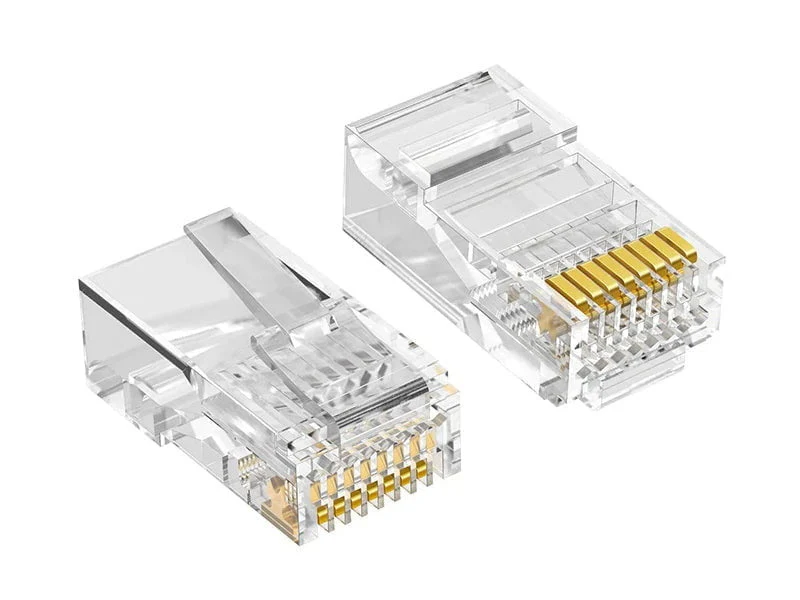In the world of networking and structured cabling, the RJ45 connector plays a small yet crucial role. It’s the little plug that connects Ethernet cables to switches, routers, and computers — forming the physical bridge for data transmission.
Whether you are an installer, a network engineer, or a purchasing manager sourcing cable assemblies, understanding RJ45 connectors helps you choose the right type for better performance, reliability, and compatibility.
This guide explains what an RJ45 connector is, how it works, different types, pinouts, and best practices for installation and selection.
What is an RJ45 Connector?
An RJ45 (Registered Jack 45) connector is a standardized 8-pin modular connector used for Ethernet networking. It connects twisted-pair copper cables (like Cat5e, Cat6, Cat6A, or Cat7) to network devices.

The name “RJ45” comes from the U.S. standard Registered Jack system, originally used for telephone wiring. However, modern Ethernet RJ45 connectors differ slightly from the original telephone jacks—they are designed for data transmission, not voice.
RJ45 connectors are found on Ethernet cables, network switches, routers, patch panels, and keystone jacks.
RJ45 Connector Structure and Pinout
An RJ45 plug has 8 contacts arranged in a row inside a transparent plastic housing. Each contact connects to one wire in the cable.
1. Pinout Standards
There are two wiring standards used worldwide:
- T568A
- T568B
Both standards define how the 8 colored wires inside the twisted-pair cable are arranged.
| Pin | T568A | T568B | Wire Function |
|---|---|---|---|
| 1 | White/Green | White/Orange | TX+ |
| 2 | Green | Orange | TX− |
| 3 | White/Orange | White/Green | RX+ |
| 4 | Blue | Blue | — |
| 5 | White/Blue | White/Blue | — |
| 6 | Orange | Green | RX− |
| 7 | White/Brown | White/Brown | — |
| 8 | Brown | Brown | — |
In most commercial networks, T568B is the dominant standard.
How RJ45 Connectors Work
RJ45 connectors ensure reliable electrical contact between each copper wire and the device port.
When the connector is inserted, the metal contacts pierce through the wire insulation and create a secure connection. The plug locks into the jack using a small plastic clip, ensuring stable mechanical retention.
High-quality connectors reduce signal loss, crosstalk, and electromagnetic interference (EMI) — all key to maintaining high-speed data transmission in Ethernet networks up to 10G and beyond.
Types of RJ45 Connectors
RJ45 connectors come in several variations to fit different installation environments and cable types:
1. Shielded vs Unshielded
- Shielded (STP): Has metal shielding to prevent EMI. Used in industrial or high-interference environments.
- Unshielded (UTP): Standard type for office or home networks. Easier to install and more cost-effective.
2. Solid vs Stranded Wire Types
- Solid conductor connectors: Used for fixed installations (e.g., wall cabling, patch panels).
- Stranded conductor connectors: Used for patch cords, flexible connections between devices.
3. Toolless vs Crimp Type
- Crimp type: Installed using an RJ45 crimping tool.
- Toolless connectors: Allow faster installation, often used in field termination.
4. Cat5e, Cat6, Cat6A, Cat7 Compatibility
Each Ethernet category requires connectors rated for its frequency and performance:
- Cat5e: up to 100 MHz
- Cat6: up to 250 MHz
- Cat6A: up to 500 MHz
- Cat7/8: up to 2000 MHz
Using a lower-rated connector limits the overall cable performance.
Common RJ45 Connector Applications
RJ45 connectors are used in nearly every wired network application, including:
- Office LAN and data centers
- Industrial automation networks
- Security camera systems (PoE-powered)
- Smart home and IoT setups
- Telecommunication rooms and patch panels
They are also critical components in fiber-to-the-home (FTTH) hybrid networks, where copper patch cables connect to optical equipment.
RJ45 vs Other Connector Types
| Feature | RJ45 | RJ11 | LC/SC (Fiber) |
|---|---|---|---|
| Medium | Copper | Copper | Optical fiber |
| Pins | 8 | 4 or 6 | 2 |
| Application | Ethernet | Telephone | Fiber network |
| Speed | Up to 10G | < 1 Mbps | Up to 400G |
| Typical Use | Networking | Telephony | Backbone transmission |
RJ45 remains the dominant connector in copper-based Ethernet due to its balance of cost, reliability, and universal standardization.
Installation Tips and Best Practices
- Use the correct crimping tool for your connector type.
- Maintain the twist of wire pairs up to 13mm before termination to reduce crosstalk.
- Avoid bending or stretching the cable excessively.
- Label both ends of cables for easier maintenance.
- Test cables with a LAN cable tester after crimping.
- For outdoor or industrial use, choose shielded and waterproof RJ45 connectors.
How to Choose the Right RJ45 Connector
When selecting an RJ45 connector for a project or OEM production, consider:
- Cable Category (Cat5e, Cat6, Cat6A, etc.)
- Shielding requirement (STP/UTP)
- Conductor type (solid/stranded)
- Environment (indoor/outdoor)
- Assembly method (toolless/crimp)
- Compliance (RoHS, ISO/IEC 11801, TIA/EIA 568 standards)
If you are sourcing bulk RJ45 connectors or customized patch cables, partner with a manufacturer who can ensure consistent pin alignment, gold-plated contacts, and tight quality control across batches.
(Internal link placeholder: RJ45 patch cable manufacturing process)
Future of RJ45 Connectors
Even as fiber optics expand rapidly, RJ45 connectors continue evolving.
Newer designs support 10G/25G Ethernet, PoE++, and industrial M12-to-RJ45 hybrid solutions.
The connector’s simplicity, durability, and backward compatibility guarantee it will remain essential in structured cabling systems for years.
Conclusion
The RJ45 connector is a small component with a massive role in network infrastructure.
Understanding its types, standards, and installation techniques helps ensure reliable connections and efficient data transmission.
Whether you’re building a data center, an ISP network, or a smart office, choosing the right RJ45 connector is key to system performance and long-term reliability.